Committee of Adjustment and OMB decisions, it is alleged, at times contravene planning legislation. Allegations of professional incompetence also arise.
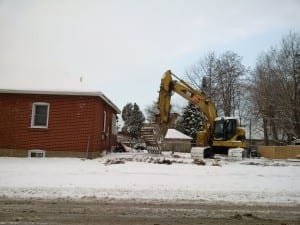
The photo, from Feb. 17, 2016, shows demolition work proceeding at 20 James Street in Long Branch in a manner – that is, in the absence of construction fencing – that demonstrates disregard for public safety. A local resident contacted 311 on the morning of Feb. 17 and received a response that said: “Thank you for contacting 311 Toronto. Your email has been forwarded to Toronto Building inspections for review / response / resolution. If you do not receive a reply within three business days, please contact them at 416.394.8055.” As it turned out, construction fencing did appear at the site later on Feb. 17, 2016. Photo source: A resident of Long Branch
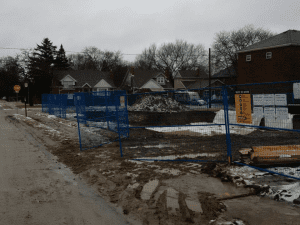
Recent activity at OMB-approved site for two twin soldiers at 20 James St at Thirty Seventh St.: Builder continues to block sidewalk and use it as its work space. Issue has been reported to Manager, Lee Salvati, and Supervisor, Bruce Hemmings, at Building Inspections. Photo source: Local resident
In a previous post I have shared a message from David Godley.
David Godley is at <mhairig@pathcom.com> and 416-255-0492.
The attachments in the message include the following text from David Godley and Wanda Jurashek of Long Branch:
You can read the text by clicking on the above-noted link. By way of bringing attention to the message, I have pasted it below.
The text is a draft; there are some typos in it. I have not corrected the typos, as I avoid substantive copy editing of texts (that is, aside from removing an extra period, or other minor changes) unless I have consulted with the author(s). In the text that follows, I have added some links, which are not included in the original text.
David Godley and Wanda Jurashek’s message, in a nutshell
The draft text concerns development issues in Southern Etobicoke and elsewhere in Toronto.

David Godley at break during OMB hearing on Feb. 13, 2015 regarding 20 James Street in Long Branch. A previous post regarding the OMB hearing is entitled: David Godley, a retired professional planner, shared evidence about 20 James Street at an OMB hearing on Feb. 13, 2015. David Godley is at <mhairig@pathcom.com> or you can call him at 416-255-0492. Jaan Pill photo
It is my understanding – and my understanding is subject to correction – that a key point of messages from Long Branch residents, as shared in recent years regarding the matters at hand, is that there is merit :
(1) in demonstrating adherence to the relevant urban planning legislation, and
(2) in demonstrating professional competence, when decisions are made that affect the taxpayers of the City of Toronto.
With regard to the matters at hand, the draft text from David Godley (who lives south of Lake Shore Blvd. West in Long Branch) and Wendy Jurashek (who lives north of Lake Shore) follows below:
Issues from January/February 2016 Committee of Adjustment EYK [Etobicoke York] Variances, especially when combined with Severances (DRAFT)
List of Issues
Is it appropriate for the COA not to consider citizen’s requests and reasons for deferral.
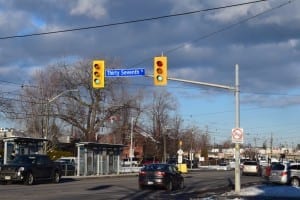
View looking east at Thirty Seventh Street at Lake Shore Blvd. West. If you travel south from this intersection to James Street you will arrive at 20 James Street, which is at the northwest corner of James and Thirty Seventh. Jaan Pill photo
Is it appropriate for COA to say that only impacts determine what is minor.
Is it appropriate for COA not consider tree issues during application consideration but rely on Urban Forestry conditions.
Is it appropriate for the Planning Reports to include to make observations on trees and perhaps other items such as extra entrances with cars backing on to busy roads.
Is it appropriate to use OPA 320 to evaluate applications.
Is it appropriate to ask applicants to address impact of key OP policies in both writing and diagrams for a complete the application.
Is it appropriate for Planning Department to settle with the applicant without involving those directly affected and revising their report accordingly.
Is it appropriate to have community meetings prior to or after COA hearings.
Is it appropriate to allow increased taxes to influence a decision.

At the southwest corner of Thirty Seventh Street and Lake Shore Blvd. West, across from the No Frills store, you will come across a Shoppers Drug Mart where the Eastwood Hotel was located before the property was demolished. Jaan Pill photo
Is it appropriate to approve 3 storey houses in low density zoning catagories anywhere in Long Branch.
Is it appropriate to have drawings and elevations included in the circulation notices for Long Branch or details posted on the internet.
Is it appropriate to take into consideration first floor rooms that are counted as basements under the zoning code as part of massing. Once these “basements” are occupied eg a carpet is laid, they increase density beyond that permitted.
Is it appropriate for the Long Branch Neighbourhood Association Group to be forwarded the agenda once it is established, like other community groups.
Is it appropriate to attach conditions to all severance/variance applications that the new buildings will be substantially the same as the plans submitted.
Is it appropriate to consider the plans submitted rather than the supporting severance and variance especially when the approval requires development to have substantially the same design as the drawings.
Is it appropriate for Planning Reports to include reasons for supporting or not supporting OP policies.

At the building just west of the Shoppers Drug Mart on Lake Shore Blvd. West, you will see a sign pointing to a hotel. The Eastwood Park Hotel the sign points to is gone; the sign remains. The Eastwood family was a key landowner in Long Branch in the years following the death of Colonel Samuel Smith, who in 1797 built a log cabin at a location east of here, namely at what is now the site of the former Parkview School at 85 Forty First Street across from the Long Branch TTC Loop. In 2010, local residents launched a successful effort to keep Parkview School in public hands. Jaan Pill photo
Is it appropriate for the Planning Reports to say the application should be refused in its current state when deferral is recommended.
Is it appropriate to add as a condition that “twin houses” should have their design contrasted to reflect the Long Branch built fabric
Is it appropriate to have differing standards for North and South Long Branch. East Alderwood has been transformed in certain sections
Is it appropriate for decision makers ie COA members not to visit the site of applications.
Context
Definitions
Planning Act Section 1, Purpose:
a) promote sustainable economic development in a healthy natural environment by means provided under the Act.
In other words “Good planning through policies eg the Official Plan and control eg Zoning”
d) provide for processes that are fair by making them open, accessible, timely and efficient.
In other words “A transparent process to which those concerned are kept informed and delivery of a decision as soon as reasonably possible”
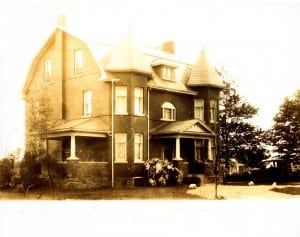
Photo of Eastwood homestead at Thirty Seventh Street and Lake Shore Blvd. A backstory related to the photo can be accessed at: A Long Branch resident passed along to Barry Kemp this photo of the Eastwood Park Hotel. Photo source: Barry Kemp of Long Branch, who received the photo from a Long Branch resident
e) encourage co-operation and coordination among various interests.
In other words “keep all those concerned in touch with each other and promote dialogue”
City of Toronto Committee of Adjustment Website
Definition of a Variance – Small changes or exceptions to existing land use or development restrictions contained in the zoning bylaw are called minor variances.
City of Toronto Variance Application
This includes a question. Why cannot the current zoning be met. Mostly the reason in connection with severances is increased profit.
Commentary
Over the last 10 years, due to decisions by the OMB with pressure from the development industry, the variance process has changed from the original intention of the Planning Act and now embraces larger changes. While the Courts have ruled that variances must be minor in size as well as impact, they have also said that size need not be expressed in a decision.
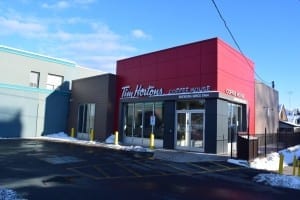
As you travel east along Lake Shore Blvd. West, from the Shoppers Drug Mart, you will arrive at a Tom Hortons coffee shop at the corner of Thirty Eighth and Lake Shore. Previously the property had been a KFC outlet. Jaan Pill photo
With a sea change in approach, variances have become more complex especially when combined with severances. This has gone hand in hand with approvals for narrow lots with 3 storey houses – an alien form to Long Branch. Many places still only use severances where they comply with the zoning eg Mississauga but in Toronto significant changes are the norm. The OMB is notorious for overriding local decisions. If the OMB were removed from the equation we would have far better planning.
In the words of one resident “Long Branch is being butchered”. This is the view of many. Other comments are “We do not want to be Bramptonised” “the new buildings look stupid”, “they are blots on the landscape”. A neutral who is environmentally aware would wonder “how has planning gone astray”. The anger and frustration was expressed at the May 4th 2015 public meeting and since then a number of positive steps have been taken by key players. However development pressure continues to increase and Long Branch is the epicentre for severances. Not only do the severances take advantage of the unique historic and aesthetic environment they start to spoil it as well. We have an extreme situation in Long Branch with the overwhelming number of applications being submitted.
The severance/variance process still uses the same method of public input it used 10 years ago and since its inception in the 1940s, despite the potential for more severe consequences especially for abutting neighbours.
A major positive outcome from this deep concern about planning is that a Neighbourhood Association is forming and about 30 people meet regularly to create the mandate of the new association. Others are that the Planning Department now send out a status report on current applications including their comments and that an Urban Design Study has been started with Long Branch being used as a test bed. Open dialogue exists between the Planning Department and the community.
Residents and owners receive notice of variances within about 200 feet a little over 2 weeks beforehand if the notice is sent out on the last day according to Provincial rules. Notice is also placed on the property in question. COA staff , of course, operate by the rule book.
However most recipients do not understand the notice, many people have not the time or inclination to go to the Civic Offices and comprehend the proposal. Really you need to employ a professional. No information is available to interpret impact such as an impact statement addressing the 4 main areas of the Official Plan, a bird’s eye view or how the new development fits into the urban fabric especially the front facade. In Switzerland 50 years ago an applicant was required to construct a life size wooden outline on site so that judgment about impacts could be demonstrated. Lack of translatable information is a barrier to community involvement.
In addition it is usually at least a 3 hour wait during the daytime to present to the COA. It is often a first time experience for residents who feel uncertain of procedures. Some find it intimidating similar to being the centre of attention in a packed courthouse. Much is often at stake for the householder.
The Planning Act puts the onus on the applicant to demonstrate that the intent of the Official Plan is met. This requires addressing policy 2.2.2 which says growth will be directed away from neighbourhoods so that their character can be respected and reinforced, policy 3.4.1 on trees, policy 3.1.2 that says new development will be “massed and its exterior façade will be designed to fit harmoniously into the neighbourhood” and avoid undue impacts on neighbouring properties and policy 4.1.5 which includes a number of criteria including massing and scale of nearby properties and a variety of criteria for development which respects and reinforces character.
The loss of trees seems to be considered as collateral damage by decision makers. The OMB actually removed a condition on 2 27th Street about trees which led to 7 100 feet high pines being lost not to mention 2 other “protected trees”. 69 Laburnham, 97 27th Street and 58 Ash are examples of trees being lost because Urban Forestry’s hands are tied when a severance/variance approval is given. They cannot refuse a permit if the development requires tree destruction.

Villa Road is located further east of the Shoppers Drug Mart, at Fortieth Street south of Lake Shore. In September 2014, the residents of the street launched a successful bid to keep a property on the street from being severed for the construction of two “soldier” houses. The residents assembled letters indicating that the overwhelming majority of the street opposed the proposed severance. Eight speakers from the area prepared and rehearsed 5-minute presentations for a Committee of Adjustment meeting, each based upon a separate and distinct reason for objection to the application. The gist of the message, from the street, was that the proposal did not adhere to the relevant urban planning legislation that is in place for the City of Toronto. David Godley served as a key resource in the planning of the submission. David is at <mhairig@pathcom.com> or you can call him at 416-255-0492. The proposed severance was deferred, after which negotiations led property owners on the street to an agreement to purchase the property from the developer. Please contact Jaan Pill at jpill@preservedstories.com if you wish further details. Jaan Pill photo
David Godley is at <mhairig@pathcom.com> or you can call him at 416-255-0492.
Urban design knowledge is required to interpret the Official Plan and the OMB and the development planners usually lack this. They believe such items as reflecting architectural features such as flat roofs or contrasting designs to reflect the different house appearance is beyond their purview. The Planning Department have urban design experts but it is not always possible to see their influence in comments. Experiential or serial vision (urban design where one looks at the effect on people moving through the neighbourhood) is absent in nearly all North American jurisdictions.
The other factor is that the City has recently adopted OPA 320 which clarifies how Section 4.1.5 should be interpreted. The OMB has favoured the notion that if there is a single similar severance in a wide area around the site then the character of the neighbourhood is reinforced and respected. Hopefully the OPA will stop this practice and deter development planners parroting this line. The test is now clarified as the predominant character and this is now City policy since it speaks with bylaws.
This lack of information is also a burden on the COA who seem to act somewhat intuitively as well as the OMB who must have regard for the local decision making file. There seems to be a bias towards development perhaps because of the thought that increased taxes accrue. It has never been shown that overall new residential development is beneficial to the bottom line – in fact quite the reverse. People need services. The new buildings are selling for over $1m. Affordable accommodation could be provided if a lot is unsevered but includes a secondary suite. We are a student oriented neighbourhood with Humber College being a neighbour.
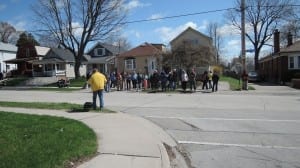
Mike James (back to camera) shares information at corner of Fortieth Street and Villa Road in Long Branch during May 4, 2014 Jane’s Walk led by Mike James and Jaan Pill. On a quiet street with a fair-sized group, a portable amplifier offers a convenient way to ensure that each speaker is heard clearly by each participant in a Jane’s Walk. Please contact Jaan if you are interested in leading a Jane’s Walk in your neighbourhood on May 6th, 7th, or 8th, 2016. Jaan and Mike no longer lead walks but are keen to help out in the organizing of them. Jaan Pill photo
There is a myth that residential development contributes to lower taxes or allows civic benefits. This is part of the reason the planning system has broken down in the context of severances accompanied by many variances.
Such applications can have as many or more problems for the community (especially abutting owners) than zoning amendments. Residents and owners have to suffer consequences of removing their rights in the form of overshadowing, overwhelming structures and overlook as well as jarring inrusions into the rhythm of the street. Development squashed on to undersized lots frequently has boundary problems such as trespass, undermining neighbours foundations, cutting down boundary trees or trees on a neighbour’s property. Builders frequently ignore building bylaws. Because of the attitude of builders neighbours are fearful of protecting their rights. People have left the neighbourhood because of the impacts, even moved Province or emigrated. Mistakes made now last for maybe 100 years.
Residents are sometimes involved in stressful discourse with applicants for years.
Neighbourhood Plans have not been used in Toronto for many years. This is where a stakeholder group is brought together and in unison with planners and other staff specialists prepare a plan together. This requires full service planning that budgets have not been able to support. Current staff are already stretched.
Community meetings have never taken place before hearings so dialogue is minimal if any. Such meetings have the benefit of allowing planners to incorporate the sense the community has of a proposal. Applicants simply want a quick answer from the COA so they can appeal to the development friendly OMB. In a progressive move the Planning Department have started to recommend to the COA that community meetings be held to bring a proposal more in keeping with the Official Plan after the initial hearing. The Councillor’s Office has been actively supporting this with written requests to the COA.
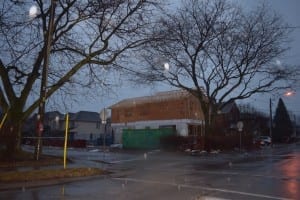
Another house on James Street, at the corner of Fortieth Street, shows an approach toward development that many residents, as I understand, favour. Instead of a severed lot featuring two “soldier” homes, we see in this Feb. 24, 2016 photo a house where a second floor is being added to an existing footprint. Such an addition, as I understand, is very much in keeping with the existing character of Long Branch. Jaan Pill photo
The Planning Act is full of provisions for the community to be able to shape their own neighbourhood within the framework of the overall City interest. “Localism’ is a national policy in some countries eg England.
Case Studies
Case Study 1 – Address unknown
The COA only allowed a deferral request by an applicant on an item on the February 11 COA meeting. Their view is that the applicant must be given the opportunity to have their proposal considered for approval or refusal. At the Committee a neighbour was told by the applicant that he would seek deferral so that she could review any modifications proposed. She stated she had no idea of the original proposal or how the proposal had been modified. Nevertheless the Committee approved the application. The OMB consider requests for deferral/adjournment from non applicants.
Case Study 2 – 88 Laburnham
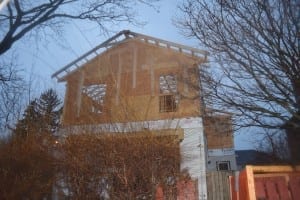
House at James Street and Fortieth Street. See previous caption for comment regarding the house. Jaan Pill photo
Revised plans had been significantly changed in order to meet the planner’s interpretation of what conformed to the Official Plan. The planner’s revised report was submitted a day before the hearing and new plans were not available to the public. The applicant asked for deferral as the Councillor had asked for that. Had the applicant not co-operated this too could have been approved.
Furthermore the planning report supported a far greater density than previously on such applications. There was no explanation in the report but was later confirmed that the extra density was within the building envelope (or box where development within the site is permitted) and that North Long Branch was not in a fabric study that had been conducted by the Planning Department for South Long Branch. The Planning Department are on record that on a refusal by the COA the Planning Department will involve the public affected in discussions with the applicant.
It should be mentioned that once the Planning Department has agreed with the developer it is difficult although not impossible for the community to win at the OMB. Residents cannot afford to spend $20,000 to $30,000 for planning and legal expertise and a great deal of time defending their current rights. There is no intervener funding. It is a difficult manoeuvre for the City to appeal an approval through Community Council and City Council and then hire outside consultants. The Councillor has to be willing to support the appeal.
Case Study 3 – 40 38th Street and 56 Ash
At the January 14 COA 2 severance applications (the 3 storey 25 feet frontage lots) were approved since no one showed up at the meeting for reasons previously mentioned but not because there was no strong objection. The COA appear to feel lack of attendance means neighbourhood support or lack of concern about the application. One site had a very similar application that COA turned down next door. The Planning Department and the Councillor supported deferral. The COA appeared not to grasp the Long Branch issues and to ignore or misunderstand the Official Plan. In addition approval of 56 Ash did not allow real planning with a possible compromise of having 3 units where 4 were proposed using the adjoining lot at 58 Ash.
David Godley,
Lake Promenade, Toronto, M8W 1C3. (South Long Branch)
Wanda Jurashek,
Twenty Second St. M8V 3M2 (North Long Branch
February 19 2016


Hi,
I am a longtime resident in the Willowdale area.
Right next to us on a 48.5 ft lot the committee of adjustment granted one of those monstrous 3-storey buildings, giving them 5 ft from the lotline. According to our measurements this amounts now to only 4 ft, plus there are a few windows looking right into our place. I had hoped that we could spend the remaining years in our house. But we as longtime residents are just being shut down, no chance basically for appealing.
I am sure wondering who these people are catering to and why.
Willowdale and Long Branch are two of the areas (among other areas) in the City of Toronto where there are concentrations of the kinds of unfortunate situations that you describe.
One of the options is to appeal a Committee of Adjustment decision to the OMB. Occasionally, the OMB rejects the application. In some cases, the local Councillor’s Office is in a position to help residents with their OMB appeal. David Godley is a good person to contact, to get a sense of what appeal option may be available, in a given circumstance. You may also wish to contact your local Councillor’s Office, to ask what is feasible, if you have not already done so.
The odds of residents being heard are not high, as the track record of decisions indicates. However, occasionally, albeit relatively rarely, the viewpoints of local residents are indeed taken into account, when final decisions are made.
Below is a link to an an online video that describes the situation we are facing, on the street where we live in Long Branch. The link also has links to two CityTV news reports, that talk about both Long Branch and (if I recall correctly) about Willowdale.
https://vimeo.com/188348481
Two Urban Planning Guidelines Pilot Projects are currently underway, in Long Branch and Willowdale. The aim, at the rhetorical level at least as I understand it, is to ensure that in future, the existing physical character of a given neighbourhood will be entered into the equation, in a systematic, organized way, as development and intensification proceeds.
How close a match will exist, between the rhetoric and the reality in relation to the Urban Planning Guidelines, remains to be seen.
A person seeks to maintain some sense of optimism, with regard to such matters but the track record of Committees of Adjustment and OMB deliberations is not promising – again, except on rare occasions, which do warrant celebration, when the interests of the wider community including those of long-time residents are taken into account.